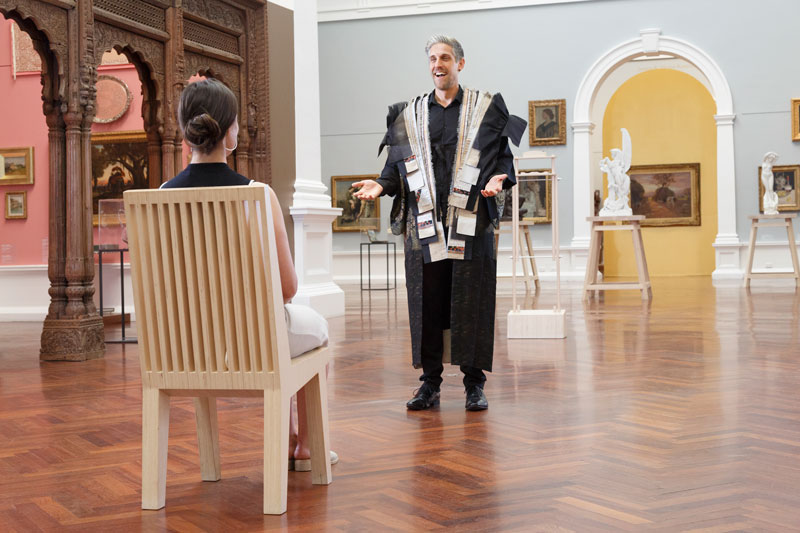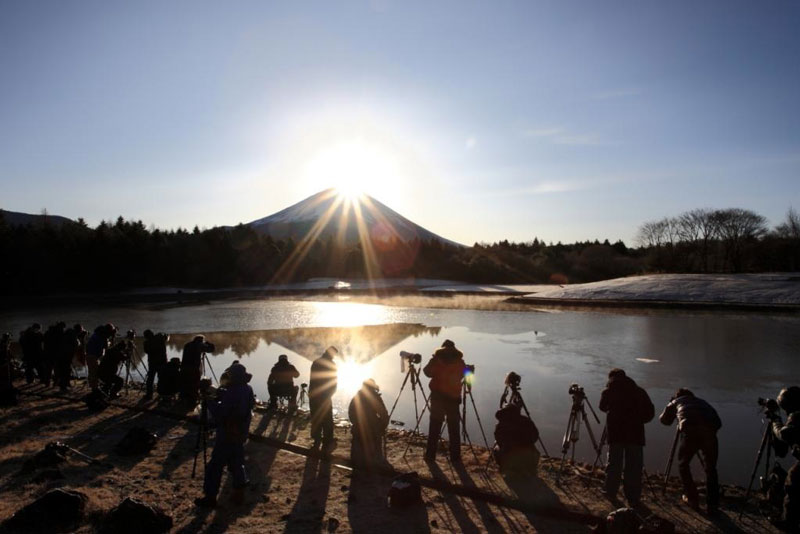
OzAsia Festival is a multi-artform festival that takes place annually in Adelaide. Ambitious in scope, it positions itself as “Australia’s leading contemporary arts festival engaging with Asia” presenting “the best of contemporary Asia in Australia each year”. Having attended the festival for some years, it is my view that it generally delivers on its claims. Through the diversity of its program, incorporating multiple art forms and cultural contexts, OzAsia avoids any attempt to present a unified, or even comprehensive, vision of Asia, or culture, for that matter. Its dynamic and experimental program of theatre, dance, music, film and visual arts, this year also included the Jaipur Literature Festival Adelaide (in its second iteration, this year even better attended), the Asia Pacific Creative Cities Conference, and the ever-popular Lucky Dumpling Market and Moon Lantern Festival.
Within these bigger agendas, the visual arts can sometimes take a back seat, but festivals reinforcing more specific cultural contexts are the life-blood of Adelaide, around which much of this city’s best programming takes place. When it comes to the visual arts, Adelaide is very good at exploring and celebrating local contexts including the South Australian Living Artist (SALA) Festival and the Adelaide Biennial of Australian Art. And OzAsia, like the Tarnanthi Festival of Aboriginal and Torres Strait Islander Art, with which it felt like it was competing as well as complementing, with both opening the same week, added this depth of critical cultural focus, also providing the opportunity to bring out some key international artists.
Fiona Tan’s exhibition, at the Samstag Museum of Art, centres on her 2016 work Ascent, a film composed of thousands of photographs of Mount Fuji sourced by the artist from the Izu Photo Museum archives and the general public. Running for 77 minutes, Tan’s carefully curated flow of images constructs a vast and varied narrative of Japan’s iconic mountain. Accompanying this visual narrative are the voices and identities of two characters, a woman who speaks in English and a man who speaks in Japanese. They talk as lovers, but their conversation meanders around the mountain, charting its place in Japanese history as evidenced through the (predominantly) visual record of its many encounters.
The photographs and images (also from art history) that compose the film are united by the presence of Mount Fuji and arranged in sequences. While narrative movement is achieved this way, Tan has not attempted to create the illusion of a moving image from stills. Each photograph maintains its discrete, separate identity while suggesting connections. A selection of the photographs are also presented in a small space adjacent to the film, displayed like a row of postcards running horizontally along the room’s four walls. A rather underwhelming entry-point to the exhibition, if intended to highlight the discrete individuality of the photographs that compose the film, then it is pushing a point more elegantly articulated in the film itself.
.jpg)
Ascent’s narration is also marked by connection and separation, proximity and remoteness. It quickly becomes apparent that the voices of these two lovers come to us not only from different locations, but from different times. Hiroshi’s words are summoned from the past, perhaps through the memory of his lover, who appears to inhabit the present as if time has been arrested by his death: “photography, like grief, stops time,” she states at one point. Hiroshi’s words convey a closeness to Mt Fuji through an intimate cultural knowledge, personal experiences, and physical proximity. In contrast, the woman’s words are defined by her distance and present location outside of Japan.
The narrator speaks of Mt Fuji through second-hand stories, received ideas, and researched facts, attempting to get closer to her lover and his world, but cognisant of the obstacles (culture, language, time, death) that keep her at a distance. The simultaneous intimacy and disconnect between these two characters is alluring because it is ambiguous, like the reference to that other “Hiroshi” of Alain Resnais’s famously melancholic film Hiroshima mon amour [Hiroshima, my love] (1959). The paradoxes are amplified by the scripted quality of the narration in Ascent: not wholly poetic, nor convincingly real. Watching the film, I was never quite absorbed in the narrative, as it very much felt like actors reading their lines.
.jpg)
The contradictions explored in Ascent provide an apt lens through which to consider the OzAsia festival itself. OzAsia is a celebration of Australia’s connection with Asia, but the very need to facilitate cultural encounters between Asian artists and Australian audiences also presumes a level of separation, a distance that the festival works to bridge. As with Ascent, OzAsia is paradoxically about both connection and separation. It is also, by extension, about both inclusion and exclusion; while OzAsia’s core aim is to engage with Asia, this focus delineates Asian and Asian Australian artists as existing outside of mainstream culture and frames their art within the cultural context of Asia.
The fact that participation in OzAsia tends to emphasise an artist’s cultural or ethnic background can be problematic for artists who do not want their work framed in these terms. Tan was born in Indonesia, raised in Australia, and now lives in the Netherlands. While her background is often cited, she has expressed frustration at her artistic practice being read exclusively through her ethnic and cultural identity. Ascent subverts and destabilises these notions, placing before us the cultural predicament, as Tan seeks the opportunity to explore a culture other than her own, Mount Fuji as the symbol of Japan being the outlier here. Too bad, perhaps, that the more-distant cultural game-play perhaps fails to convince, other than to reinforce the fact that in our cultural encounters we inhabit multiple identities and play multiple roles, with varying degrees of connection.
.jpg)
OzAsia’s engagement with India this year seems to centre on intercultural connections and collaborations. From Surpassing the Beeline, in which Indian-born and Amsterdam based Abhishek Thapar curates a theatrical-culinary experience in collaboration with expatriates from both Amsterdam and Adelaide, to the second iteration of the Jaipur Literary Festival Adelaide, which brings together over 60 speakers from across Australia and Asia to converse “about myth, privilege, history, violence, gender, hope and peculiar places.” Within the visual arts program, Sisters Sangam at SASA Gallery extends the conversation through an exhibition of collaborative works made by artists from South Australia and Jaipur. While OzAsia’s model focuses on facilitating encounters between artists and audiences, Sisters Sangam gives equal weight to encounters between the artists themselves. In 2017, four South Australian artists visited Jaipur, India, and spent eight days working with ten local artists. The impressive array of collaboratively made works that form this exhibition is the result of their short time spent together.
“A camel is a horse designed by a committee” goes the well-worn saying, invoked to express the dangers of collaboration. But a camel is actually a pretty interesting animal, and in the context of this exhibition represents a successful outcome of the collaborative process. Hansraj Kumawat and Daniel Connell’s She-Camel is a beautifully constructed sculptural form in brilliant pink, which locates the camel as a point of connection between the two artists, referencing the large-scale importation of these animals to Australia from India and Afghanistan in the late-nineteenth and early-twentieth century. There are many such collaborative successes in Sisters Sangam, from Zoe Freney and Tabeenah Anjum Qureshi’s collage of charcoal and digital prints to Anjali Shekewat’s video animated drawings responding to interviews with the artists.
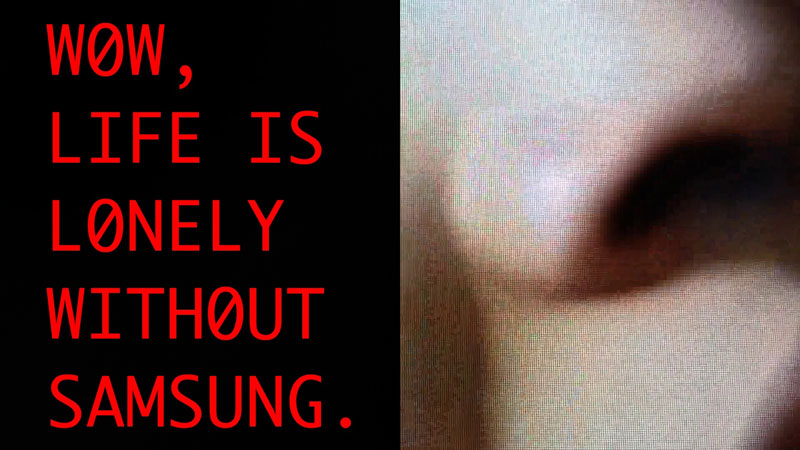
I’m ashamed to say that Samsung Loves Us All at the Adelaide Festival Centre’s QBE Galleries was my first encounter with the work of Young-Hae Chang Heavy Industries (YHCHI). There really is no excuse, as pioneers of net art, YHCHI’s Flash animations have been available online for almost twenty years. But I knew none of that when I first saw their work and instead experienced the thrill of a new discovery. The fast-paced flash of text across three screens timed to an upbeat jazz soundtrack was instantly engaging and I was easily drawn into the stream-of-consciousness style narrative of each work. YHCHI have been generating works of this kind for almost two decades, resolutely sticking to the same formula, from the low-tech application of Adobe Flash to the use of Monaco typeface. They have developed an incredibly effective form of communication, binding sound, image and text in a manner not wholly unlike the indoctrination techniques of the Cold War era.
Samsung Loves us All brings together three Samsung-inspired works by YHCHI: Samsung Means to Come, Samsung Means to Die, and Samsung Means to be Reborn. In Samsung Means to Come, the narrator is plagued by the question “How can I come with Samsung?”. She ruminates obsessively and pesters anyone within earshot until finally, in her mother in-law’s kitchen, Samsung provides her with a life-altering experience (“KABOOM!”). Samsung Means to Die tracks the life of an individual from birth to death, every moment permeated and branded by the corporation. It begins: “Congratulations, you are born in Samsung hospital. Your parents take you home in their Samsung car.” Together, the three works communicate the full force of Samsung’s omnipresence in Korea and the extent to which this corporation has become embedded in the Korean identity and psyche. By extension, it speaks to global audiences of the ever-expanding reach of technology and our gleeful embrace of consumerism.
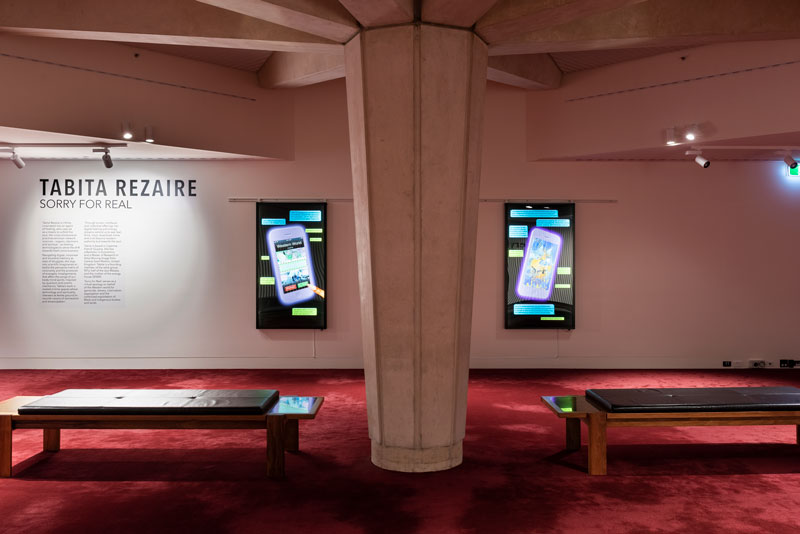
In an adjacent gallery space in the Adelaide Festival Centre, the French Guyanese/Danish artist Tabita Rezaire also blends humour and activist anger using communications technology, and the messaging of mobile-phone technology. In Sorry for Real, the “Western World” calls and unnamed recipient to apologise for “creating a system that oppresses and subjugates”. The intended recipient has no interest in taking the call, but the apology is nevertheless forced upon them through a series of text messages, depicted across five light boxes and a video work. The recipient responds to the texts with disinterest (I wish I could just delete contact. Move to trash!), cynicism (So are you gonna stop killing us?), bemusement (So now we all forgive you and move on? LOL), and anger (AND STOP BEING SO F****** ENTITLED!!). The Western World appears not to register any of this, ploughing on robotically with its predetermined script.
OzAsia also features a strong Taiwanese contingent this year, with Joyce Ho, Su Hui-Yu and Taiwanese-American Lee Mingwei, as well as the theatre event The Village and music duo Fade to Blue. It is an interesting time to spotlight art and artists from Taiwan. Tensions with China continue to build in the lead up to Taiwan’s presidential elections in January, as China (suspecting Taiwan’s President Tsai-Ing Wen of seeking formal independence) intensifies its campaign to bring what it considers to be a rogue territory under central control. China’s push for a “one country two systems” model is met with continued resistance from within Taiwan, heightened no doubt by observing a similar arrangement in Hong Kong where citizens currently fight to maintain autonomy. Intentional or not, the timing does suggest a show of solidarity, especially as two of the artists (Joyce Ho and Su Hui-Yu) explore in their works the changing nature of Taiwanese society and its relative freedoms.
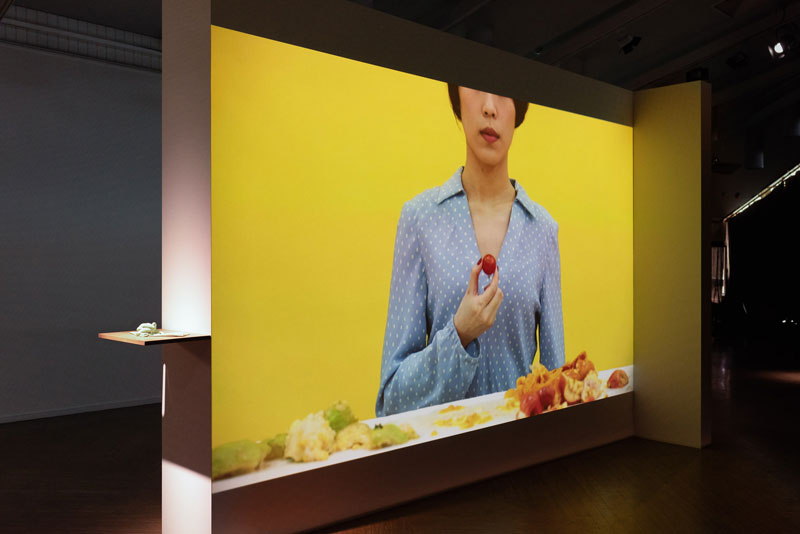
Still is a counter-intuitive title for Joyce Ho’s exhibition at the Artspace Gallery in the Adelaide Festival Centre, appearing as it does to centre around movement and gesture. But this is, in fact, an elegant introduction to Ho’s sense of play. The exhibition’s entrance is framed by a border of heavy steel gates which, sturdy as they appear, begin to rock at the slightest touch. Still showcases the full breadth of Ho’s practice, integrating painting, sculpture, installation, video and performance. There are perhaps a few too many works in this exhibition, crowded to one side to accommodate for the idiosyncracies of the space (framed by metres of black curtain where a more conventional gallery might have white walls) but, partly for this reason, it is clearly the screen-based works that grab the attention.
In Overexposed Memory (2015), a woman slowly pierces the rind of an orange with red painted fingernails, releasing a juicy, pulpy mess. And, in Vera X (2019), a domestic space of dull browns and white, the same woman appears here as a robot-like maid, moving silently and unobtrusively around the space to perform her tasks with meticulous care before storing herself away. In Animal, colour and its absence are this time combined: a woman’s hand and wrist rests upon a clean white surface, bare but for the cuff of a crisp white shirt and the nail of her ring finger, which glistens with a deep blue polish. Tentatively at first and then with increasing urgency and agitation, the woman smears the colour from her nail, dissolving the appealing perfection of the image into a mess of blue pigment.
The woman who appears in these three works is not Ho but her long-time collaborator, the actor Vera Sung. Ho directs Sung within tight parameters, leaving no room for improvisation which, combined with Sung’s incredible ability to create tension from the most minute gestures, turns seemingly mundane movements into actions of consequence. Ho builds the anticipation and, mercilessly, allows for no release, leaving the audience feeling slightly perplexed. While Vera X conveys the subject’s acquiescence, to systems of control, Overexposed Memory and Animal seem like bold acts of resistance, pretty images undone by the smear of nail polish and the mess of bursting fruit.
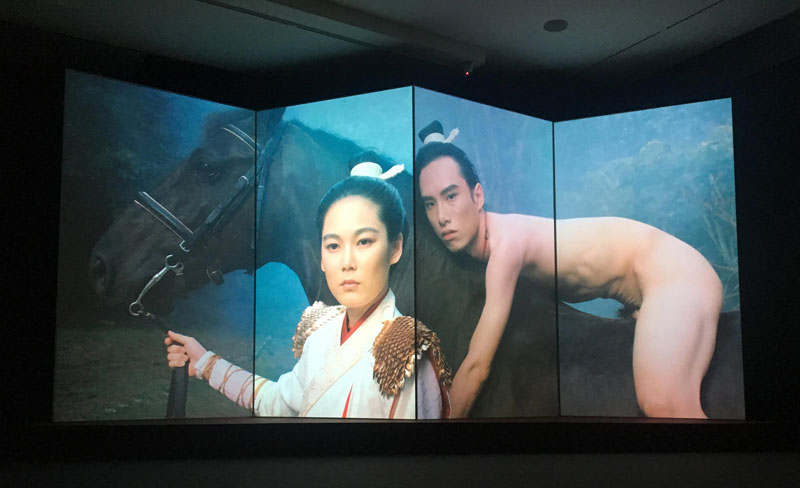
Gender issues are further explored by Taiwanese artist, Su Hui-Yu, through his film The Glamorous Boys of Tang (2018) showing at Nexus Arts, in the confined but rather more intimate space than its previous showings in large-scale museum venues. Taking its name and subject from the 1985 film created by Kang Chien Chiu, Hui-Yu’s four-channel installation displayed as a traditional fold-out screen, reimagines scenes from the original script that never made it into the film, possibly due to censorship. In the opening scenes of Hui-Yu’s work, the camera pans across a rainforest, following the slow drift of a steamy fog to land on the naked body of a young man draped across a horse. The horse is held at the reins by a woman with a warrior-like fearsome stare.
This strange yet alluring composition rapidly unfolds into a mind-bending sequence of sex and violence, as expressions of excess. In depicting scenes that were once considered too controversial for a Taiwanese audience, The Glamorous Boys of Tang highlights changing attitudes towards gender and sexuality (Taiwan being the first nation in Asia to legalise same-sex marriage), and contrasts the censorship of Taiwan’s martial law period (1949–87) with the creative freedoms enjoyed under the current democratic system. The film therefore has a celebratory feel; the characters engage in reckless debauchery as if, having been thwarted back in 1985, they can now revel in their new-found freedoms.
Sonic Blossom by Lee Mingwei is a participatory performance at the Art Gallery of South Australia occurring throughout November. Mingwei’s practice focusses on facilitating intimacy between strangers through carefully orchestrated encounters. In Sonic Blossom, the encounter occurs through the gift of song, offered to the gallery visitor. If the visitor accepts, the singer proceeds to perform one of Schubert’s Lieder. Like so many of the visual artists in the OzAsia program, Mingwei takes on a directorial role, from auditioning the key roles to carefully framing the scene within the gallery space. But unlike Tan, Ho and Hui-Yu, he leaves a part of the narrative up to chance, opening his work up for the audience of one to step in and complete.
I attended one of the opening events for Sonic Blossom, and like most openings it was not the best time to experience the work. The success of the encounter was perhaps hampered by the number of eyes and cameras on the exchange. It is difficult to achieve intimacy with a stranger at the best of times and even harder in a room full of other people. But even in this context, the emotive power of the music framed within the classical architecture of the gallery was immersive enough to establish a connection between two strangers. I can imagine that on a regular day, with just a few people wandering the gallery, the intimacy of the exchange would be further amplified.
Like Sonic Blossom, the best of OzAsia is focused on facilitating encounters that might not otherwise take place.
